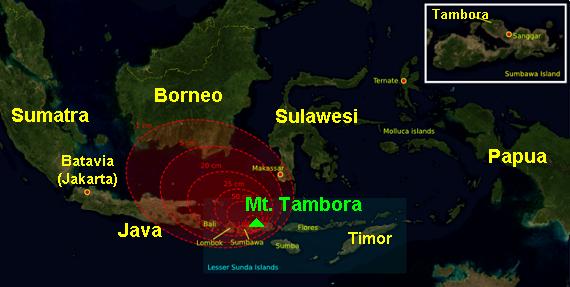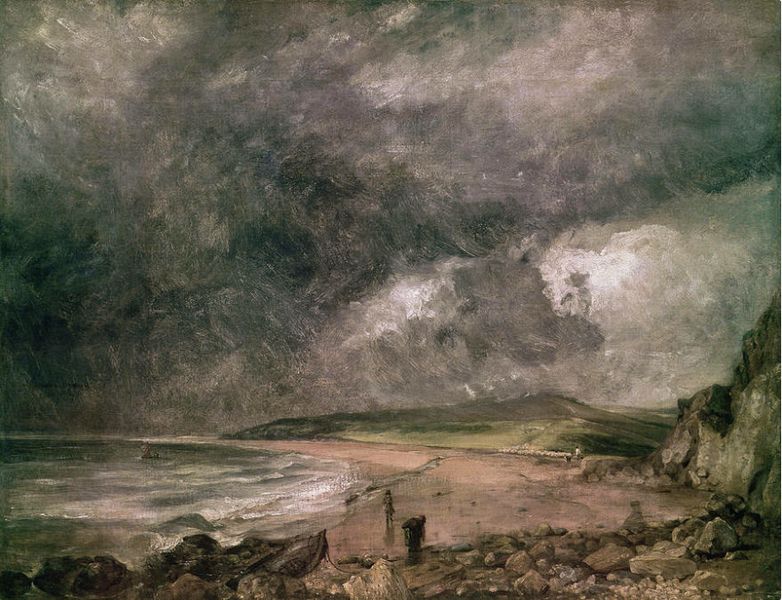
On 10th April 1816 visitor to Madura, an island to the east of Java, Indonesia, reported hearing the sound of explosions . Similar to the sound of firing, they grew louder as night fell. The sky grew dark as if a squall was approaching, but there was no gale, no rain. Going onto his veranda at 9 am the following day he observed:
The darkness overspread the whole heavens, instantly obscured the sun, and left us in pitch darkness…the darkness was so complete once could not see a single inch before or behind…
At 4pm the sea suddenly rose by 4 feet, causing destruction to boats as it rushed into the harbour, while for two days ‘brown ashes as fine as flour’ fell, covering trees and shrubs in dust. It was only a month later that news arrived confirming that there had been a volcanic eruption at Mount Tambora, and it would be months before European newspapers reported the eruption (Dublin Evening Post).
In June 1816 the Dublin Evening Post described the near-annihilation of the local population
Of all the inhabitants of the towns of Tombora and Peccate, which amounted to 12,000 persons, only 26 remain, who fortunately had gone a journey to the eastwards at the time. A dreadful famine has been the consequence; all the corn, fruits and animals, near the spot, have been destroyed, the springs covered up, and wherever water could be found, it had become of so noxious a quality, as to occasion immediate sickness, to those who drank it.
The consequences of the eruption were felt as far away as Europe where it gave rise to unusual weather conditions, though at the time this connection was not known. Because of the adverse weather, 1816 became known as the ‘year without a summer’.
The Impact of the Tambora Eruption on European weather

In July 1816, the Dublin Evening Post reported several days of ‘heavy rains, unnatural at this period of the year, which have occasioned much damage by the swelling of the river over the low grounds between Lucan and this City’. Severe thunder- and hail-storms were reported all over the country, damaging crops.
Ireland was not alone. In a series of articles, the Dublin Evening Post described the weather across Europe. The London correspondent remarked on the ‘strange and unseasonable weather’ which was an ‘unexpected visitation from Heaven’ and ‘infused into the minds of the people generally the greatest apprehension and alarm’.
In June an inhabitant of Bordeaux explained:
We sit with our doors and windows closed and fire burning as in the middle of winter. It is as cold as in October, and the sky is dark and rainy; violent winds, accompanied with heavy rain and hail rage round our country houses…
The river Maine rose high enough to enter Frankfurt’s city gates – an occurrence that was ‘almost unparalleled…at this season’. The residents of Copenhagen observed that there were no strawberries to harvest, something that had not occurred within living memory, while their neighbours in Sweden offered up prayers for a change in the weather.
In Italy, the clergy assisted the population of Naples who were ‘terrified’ when they experienced earth tremors, concerned that they heralded volcanic eruptions. In late June, the country had been covered in a flour-like substance that smelled of sulphur. Across the Atlantic in Quebec ‘a number of birds, which are never found but in the distant forests, resorted to the city’.
Back in Ireland, concerns about the harvest were justified. On 29 August a Limerick correspondent observed that ‘the morning is dark and lowering, and seems to indicate a change, which would be ruinous [to the harvest]’. There followed a week of ‘unceasing and extraordinary rain’. By September 1816 the Dublin Evening Post were cautioning their readers to expect ‘a very defective crop’.
Dry weather at the beginning of October meant that Cork farmers were ‘busily engaged in turning the sheafs, stacking and carrying’ but in the middle of the month the weather broke suddenly and unexpectedly, with heavy rain followed by frost, damaging those crops that were exposed (Dublin Evening Post, 19 October 1816). In November the Dublin Evening Post noted that ‘from Cork we know, the most deplorable accounts have been received in Dublin’ (19 November).
By 1817, Ireland was in a state of near-famine, with outbreaks of typhus increasing at an alarming rate. In September 1817 The Scots Magazine reported
For several weeks past a most alarming typhus fever has been raging in Ireland; scarcely any part of the country being free from it. This wide and rapid extension of the disease has been effected by hordes of beggars traversing the island in every direction; who, pressed by famine, rush into every house the aspect of which affords the hope of relief, and the same breath that thanks the owner for his charity, blasts the hand that bestows it, and spreads desolation through his family.
At this time it was not known that typhus was spread through lice. The epidemic continued throughout 1818, and only came to an end in February 1819. It is estimated that 65,000 people died from it, with a million and a half being affected by it (Fenning, 1999).
Impact of the Tambora eruption on Art and Literature

The weather conditions inspired a number of artists and authors. In July 1816 Byron wrote his poem ‘Darkness‘, while Mary Shelley’s Frankenstein and John William Polidori’s The Vampyre are also believed to have been influenced by the weather conditions that year. In Ireland, James Clarence Mangan wrote his ‘Lament over the Ruins of the Abbey at Teach Molaga’ in 1816. This lyric poem contributes to an abiding atmosphere of change and loss, and is further discussed in our Art and Literature section: A Coastal Poem?
The effects of the Tambora eruption are also thought to have influenced works of art. For several years after the eruption, striking red and orange sunsets were observed, and these are thought to have influenced the work of artists such as Turner and Constable. Scientists have analysed their paintings, along with many hundreds more completed between 1500 and 2000, suggesting that they may provide information on the composition of the past atmosphere (Zerefos, 2015). The post-Tambora skies may have also influenced Irish painter, Francis Danby, known for his paintings of sunsets.

